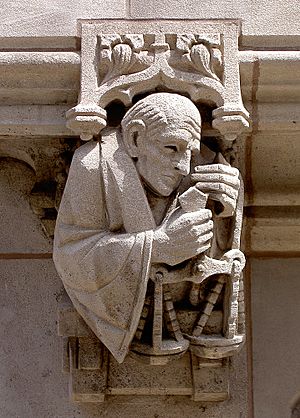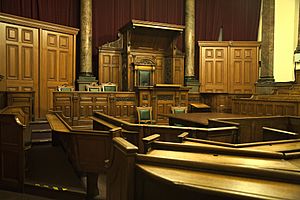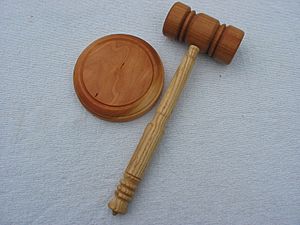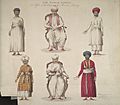Judge facts for kids
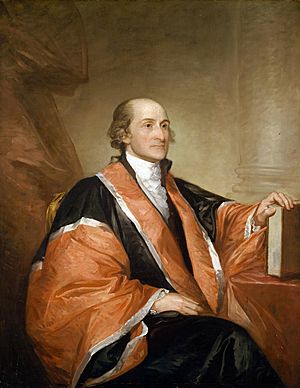
John Jay, an early Chief Justice of the Supreme Court of the United States
|
|
| Occupation | |
|---|---|
| Names | Judge, magistrate |
|
Occupation type
|
Profession |
|
Activity sectors
|
Law, Justice |
| Description | |
|
Education required
|
University degree in law and experience as a lawyer |
|
Fields of
employment |
Courts |
|
Related jobs
|
Barrister, prosecutor |
A judge is a very important person in a court. They lead court meetings, sometimes alone or with other judges. Judges listen to all the facts and arguments in a case. They hear from witnesses and look at evidence.
After hearing everything, a judge makes a decision. This decision is based on the law and their own judgment. In some places, a jury might also help the judge make decisions. Judges must be fair and unbiased.
What Judges Do
The main job of a judge is to solve legal problems. They make sure that the rule of law is followed. Judges have a lot of power. For example, they can order police to search places or arrest people. They can also order property to be taken.
Judges also make sure that trials follow the rules. This helps everyone get fair treatment. Higher courts, like appeals courts, can check a judge's decisions. This helps keep the system fair.
Before a trial, police or prosecutors gather facts. In court, there are usually three main legal people. These are the judge, the prosecutor, and the defense lawyer.
Judges might work alone for smaller cases. But for big cases, like criminal trials, they often work in a group. Sometimes, judges have assistants called law clerks. They also have bailiffs who help with security.
Becoming a Judge
There are different kinds of judges. Some judges, like English magistrates, are volunteers. They do not need special legal training and are not paid.
Most professional judges must have a law degree. In the U.S., this means going to law school. Judges are often chosen by a country's leader. In some parts of the U.S., people vote for judges in an election. It is very important for judges to be fair to everyone.
Judges need to read many documents. They must understand complicated cases. They also need to know a lot about the law. This means they need to be good at thinking logically. They must also be good at making decisions.
Judges write important documents, so good writing skills are a must. They work with many different people. So, they need to be good at solving problems and getting along with others. Judges must also have a good reputation.
Symbols of a Judge's Job
Judges often have special traditions and symbols. A Gavel is a small hammer used by judges in many countries. It has become a symbol of a judge.
In many parts of the world, judges wear long robes. These robes are often black or red. They usually sit on a raised platform during trials. This platform is called the bench.
American judges often wear black robes. They use gavels for ceremonies. However, their main way to keep order is through court officers. They also have the power to declare "contempt of court" if someone misbehaves. In some western U.S. states, judges used to wear regular clothes. In Italy and Portugal, both judges and lawyers wear special black robes.
In some countries, especially in the Commonwealth of Nations, judges wear wigs. The long wig often seen with judges is now mostly for special events. In the past, it was part of their everyday clothing.
Images for kids
-
A 17th-century Spanish judge in full robes, painted by Velázquez.
-
Róbert Ragnar Spanó, president of the European Court of Human Rights.
-
The United States Supreme Court in 2010.
-
Judges of the Supreme Federal Court of Brazil.
See also
 In Spanish: Juez para niños
In Spanish: Juez para niños


